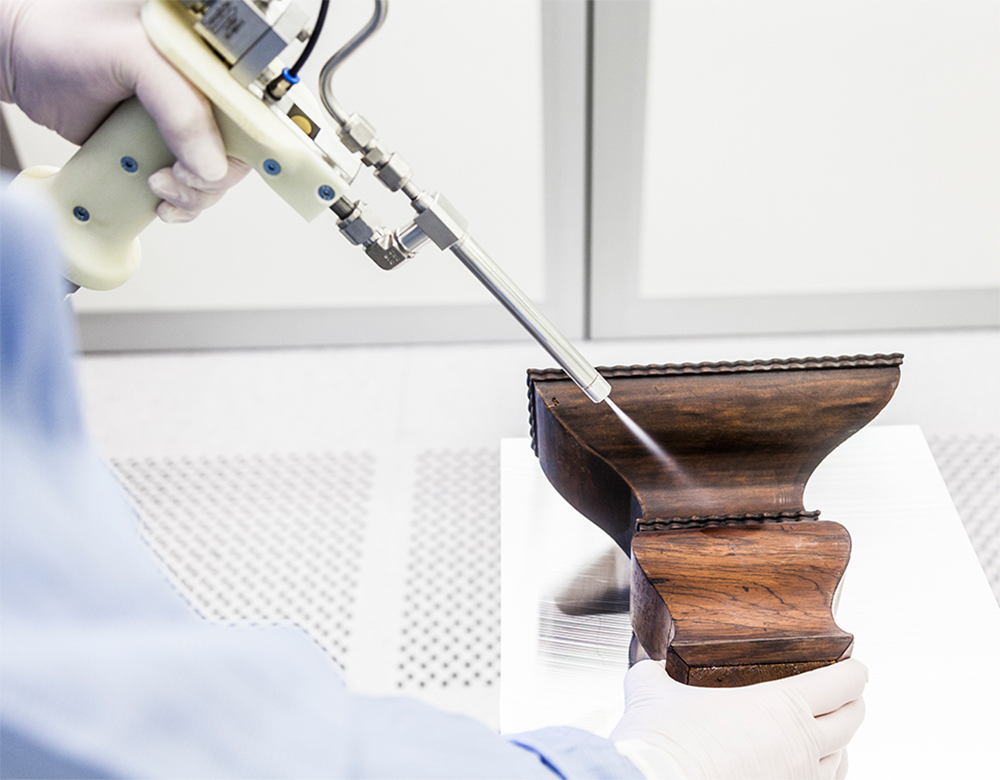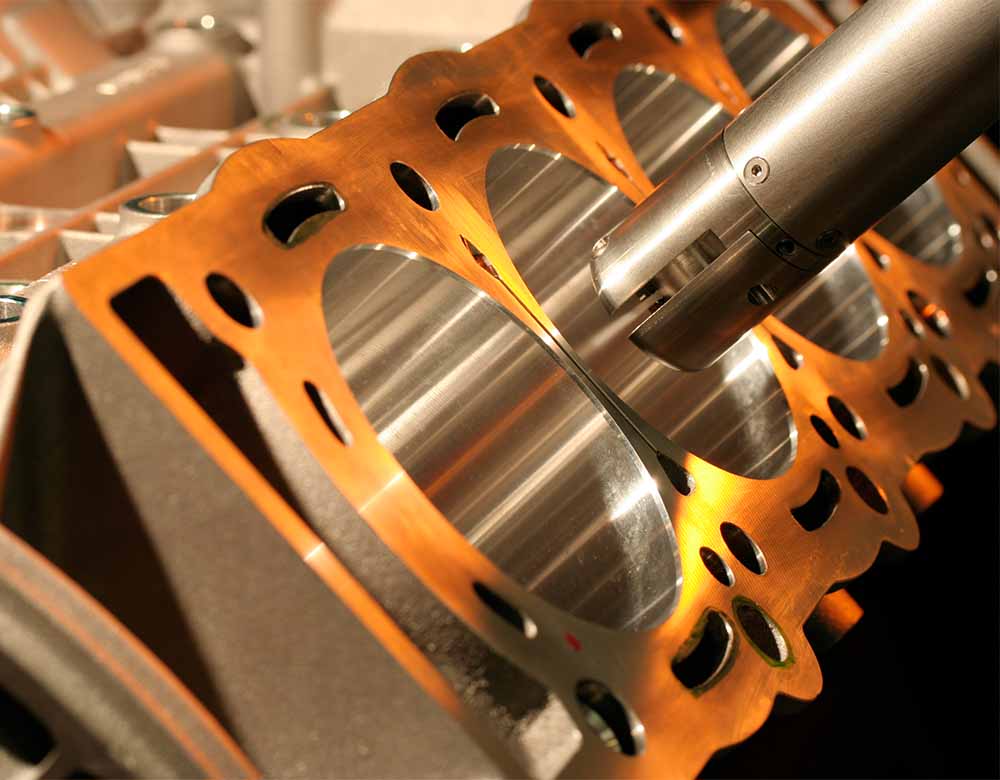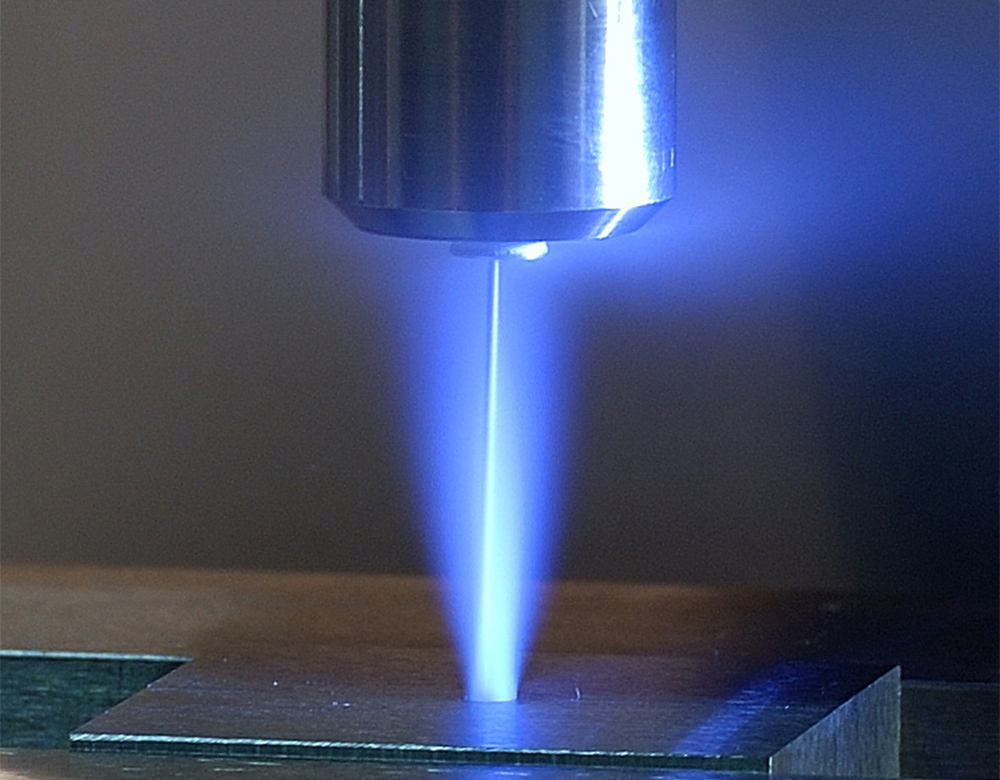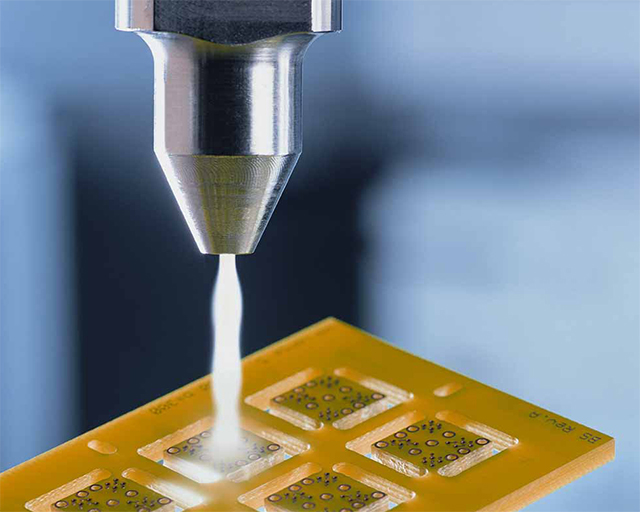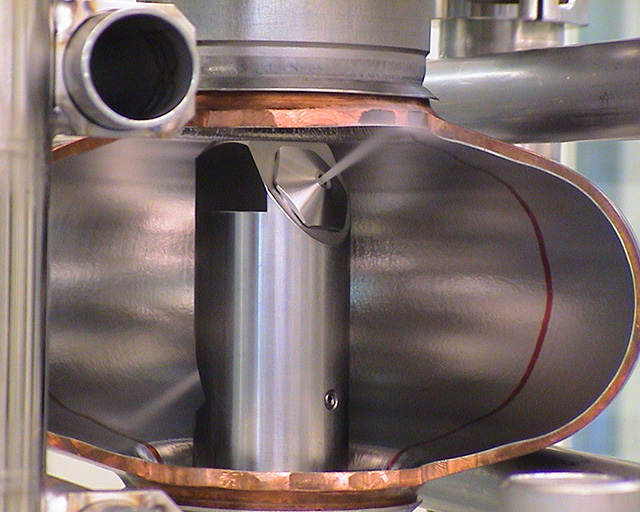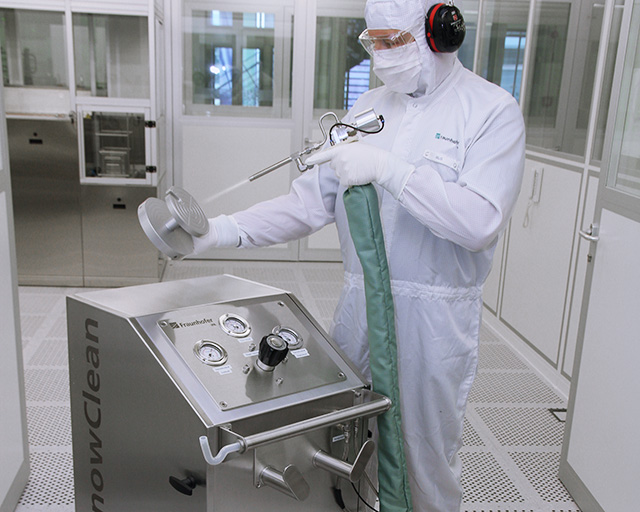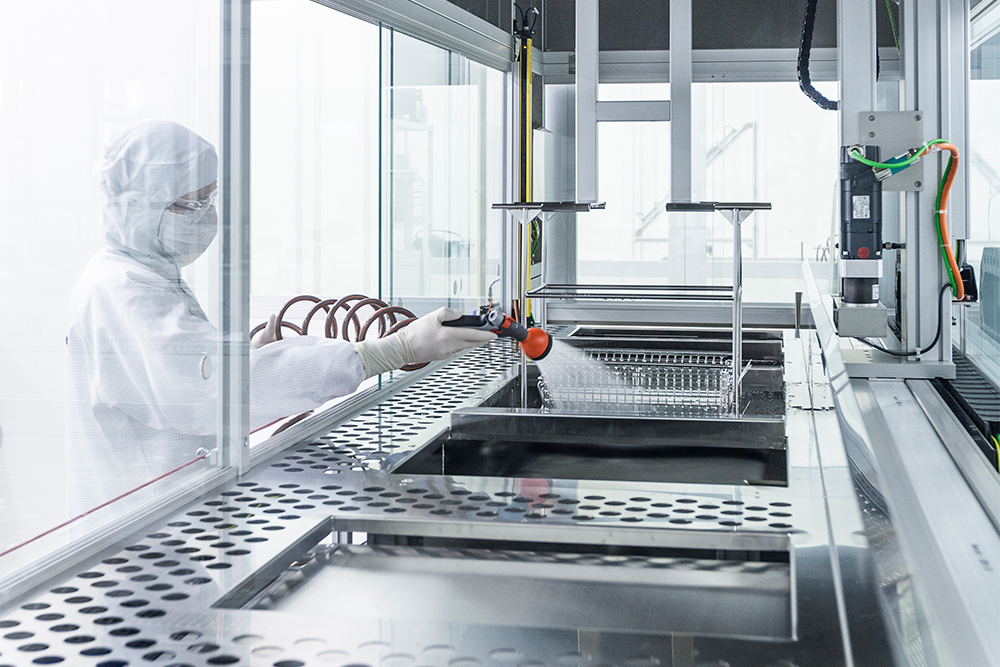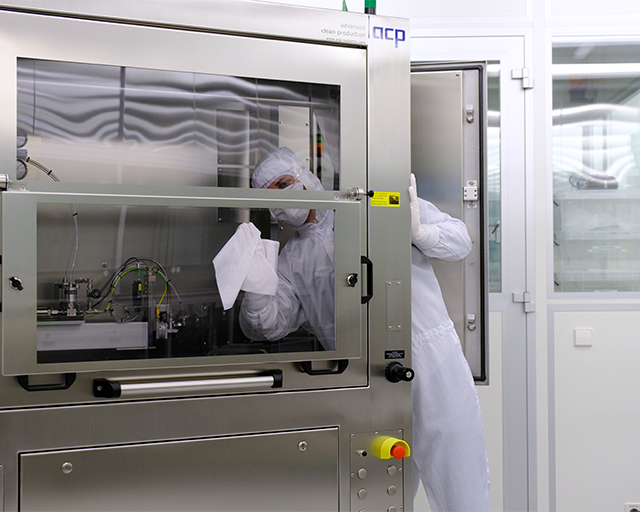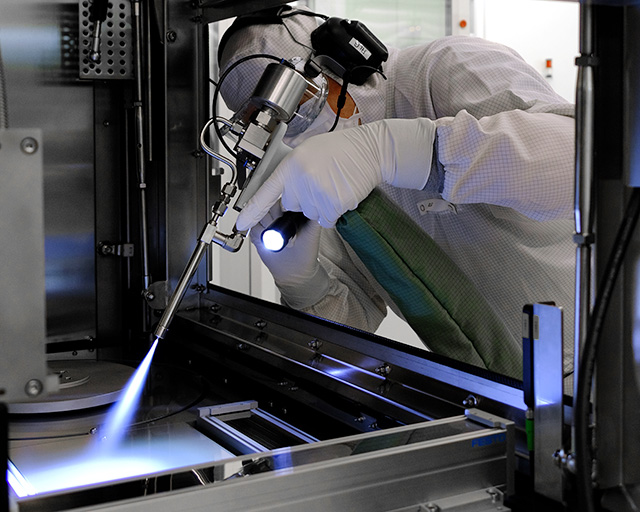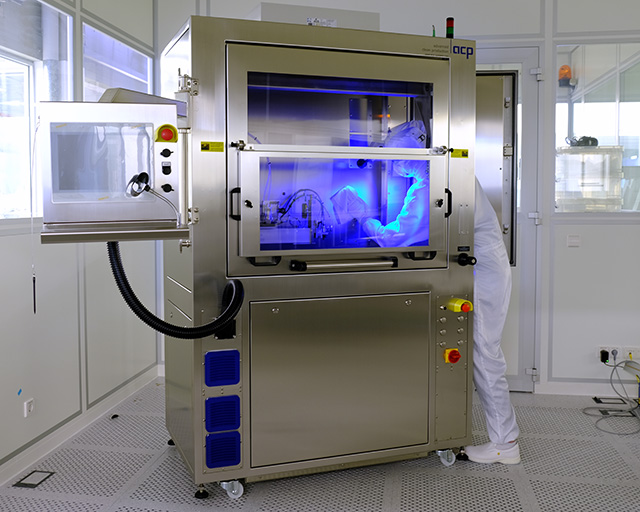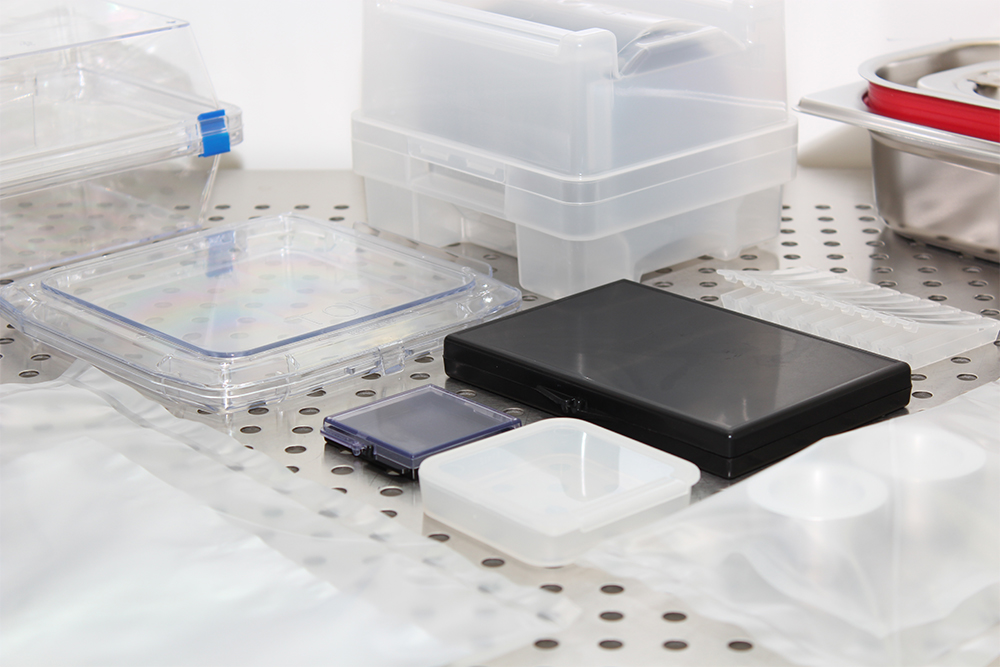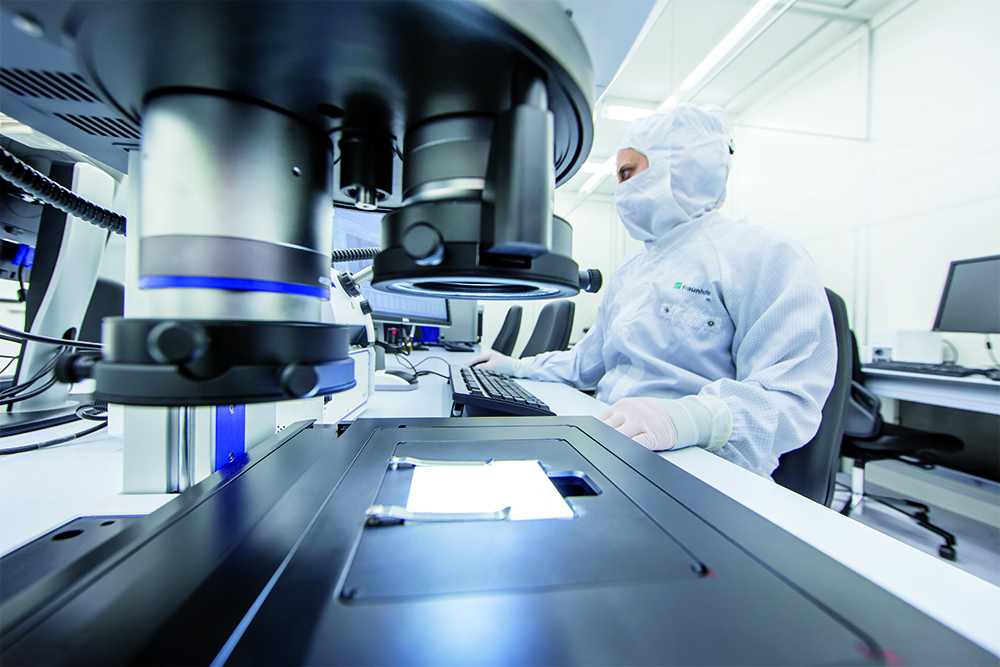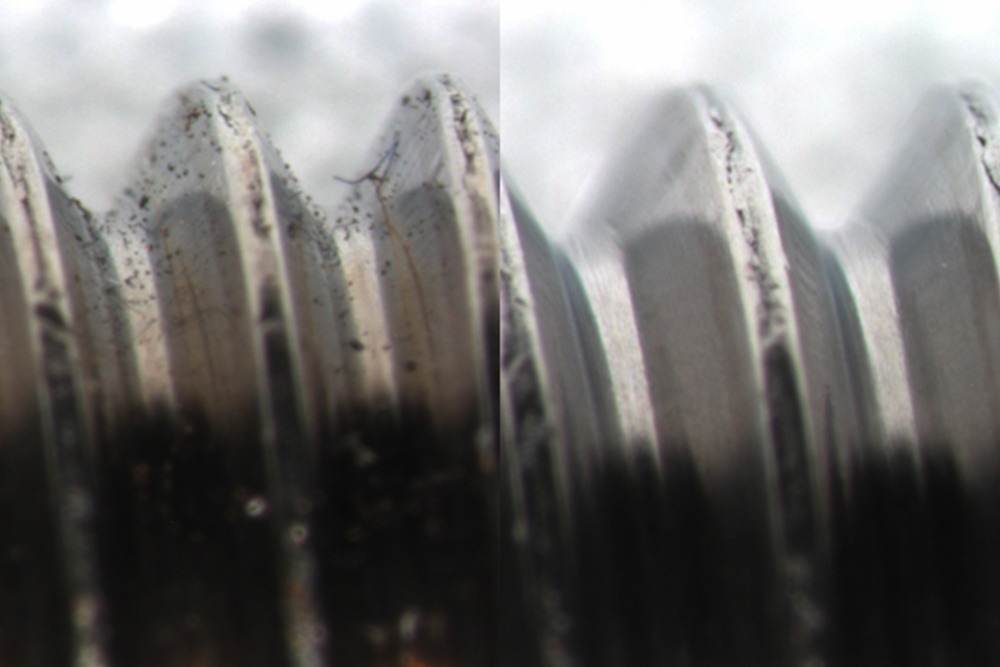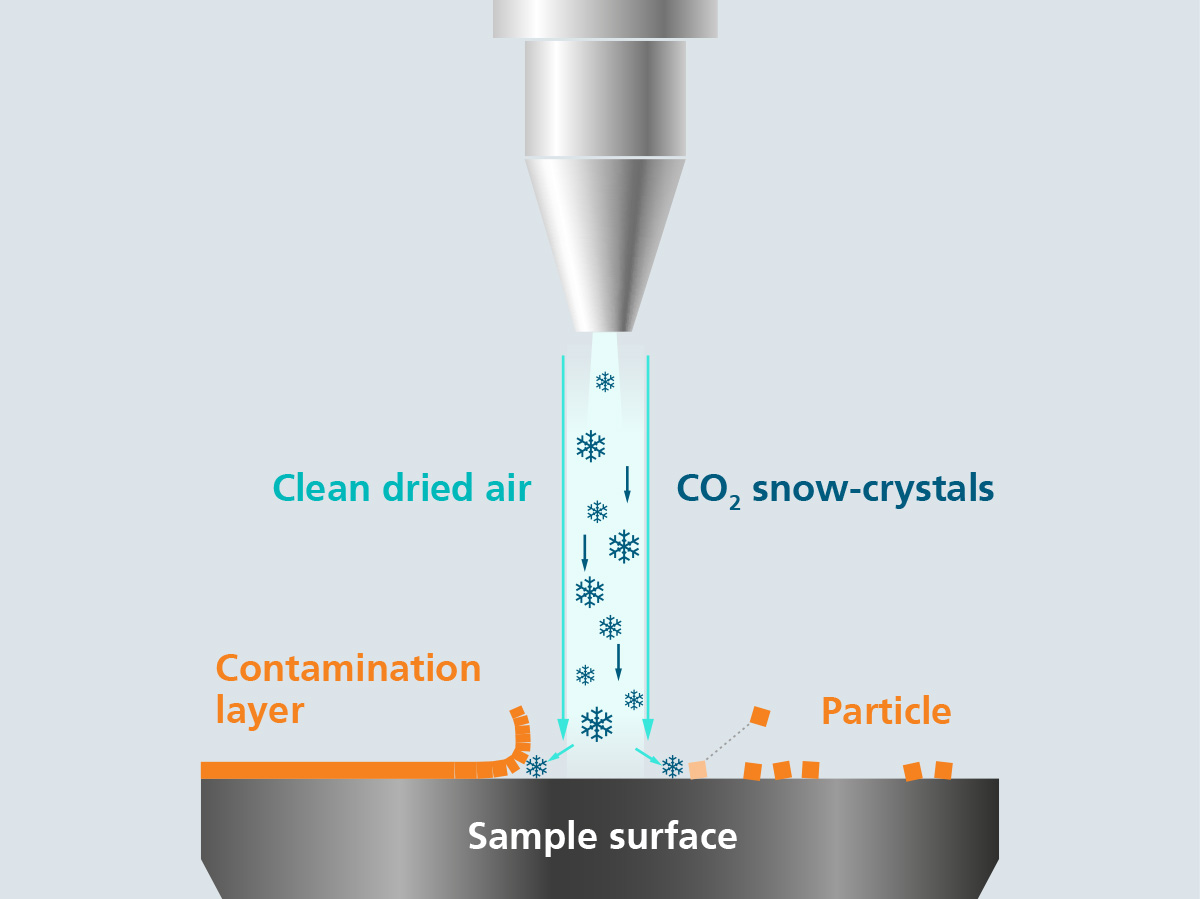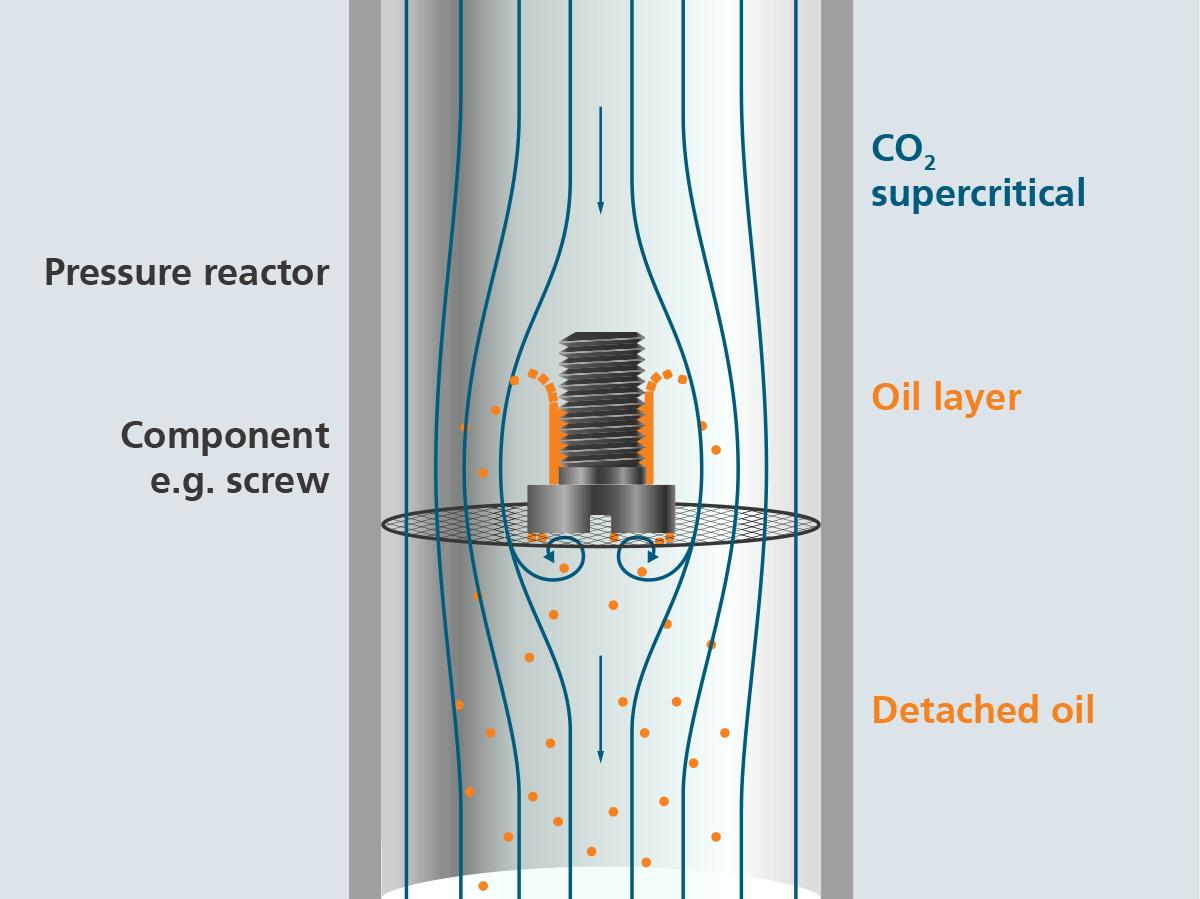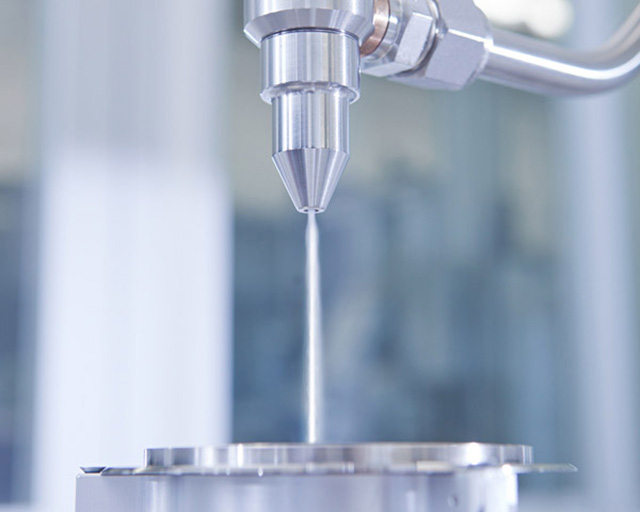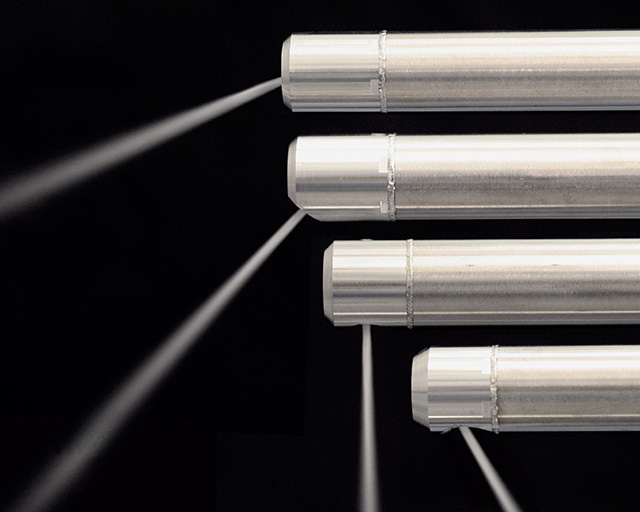
Cleaning technology

For customers with very high cleanliness requirements, such as in medical technology, aerospace or semiconductor process equipment manufacturing, Fraunhofer IPA offers consistent, traceable and validatable cleaning solutions. Our service portfolio in the field of cleaning technology is highly diversified. We evaluate and optimize cleaning processes (also on-site at your facility), develop individual cleaning processes, devices and tools, take on cleaning orders for various large individual parts, very small series, devices and systems, as well as the subsequent packaging of the cleaned goods.
Tabbed contents
CO₂-Snow
Cleaning with CO2-snow
In CO2-snow jet cleaning, liquid CO2 is expanded in a two-substance nozzle patented by Fraunhofer IPA and the resulting CO2 snow is highly accelerated by means of compressed air. If the CO2 snow jet is directed at a surface, particulate and filmic contaminants adhering to it are effectively detached by the impulse of the CO2 snow crystals and can then be extracted. In addition to cleaning surfaces, the CO2 snow jet can also be used to roughen surfaces in a targeted manner.
Advantages of CO2-snow jet cleaning
- Efficient dry process: A post-process drying of the components is not necessary.
- Residue-free: No additional chemicals or blasting agents are produced, so there is no need for disposal.
- Wide range of applications: from small local functional areas to large interior and exterior surfaces
- Manual and automated application
Since we have been working in the field of CO2 cleaning for more than 20 years, in addition to our experience we provide a wide range of cleaning tools. We can use these tools for your application specific feasibility study or process development.

Privacy warning
With the click on the play button an external video from www.youtube.com is loaded and started. Your data is possible transferred and stored to third party. Do not start the video if you disagree. Find more about the youtube privacy statement under the following link: https://policies.google.com/privacyCO₂-supercritial
Cleaning with supercritical CO₂
Conventional cleaning methods reach their limits, especially when cleaning areas that are difficult to access, such as undercuts, blind holes with a high aspect ratio, capillaries and implants.
CO2 offers a solution. In a supercritical state (> 74 bar, > 35 °C), it has excellent solvent properties and extremely good crevice mobility. These characteristics are necessary for cleaning hard-to-reach component areas or rough surfaces. By adjusting the pressure and temperature, the solvent properties can be customized according to the application.
We provide different cleaning tools for application-specific process developments and feasibility studies:
- Cleaning injectors: For supercritical cleaning of bag holes and small parts.
- Purge reactors: For supercritical internal cleaning, e.g. of thin tubes and capillaries.
We develop cleaning processes adapted to your applications, if required also in combination with CO2-snow. In both areas, we can support you with many years of cross-industry experience.
Aqueous media
Cleaning with aqueous media
Aqueous cleaning includes those cleaning processes that are based on water as a medium. In this context, water is extremely versatile and has been proving itself for two decades as an alternative to environmentally harmful, halogenated, hazardous or flammable fluids. Some of the machines and processes that allow water-based cleaning are not possible with hydrocarbons, and vice versa. Therefore, they do not compete with each other, but rather complement each other. The areas of application for water-based cleaning are extensive. From mechanical removal with high-pressure nozzles, cleaning and disinfection with superheated steam in cleaning-disinfection units, high-precision cleaning of optical components with ultrasound, megasonic and ultraclean water, to processes with deionized water and high-performance plastics to prevent unwanted ions, everything is possible. Whether handcraft, medical technology, aerospace or semiconductor industry, a water-based cleaning is used in almost all industries.
We provide support in the selection of a cleaning process as well as in the creation and optimization of a suitable process for your application. For this purpose, we can access the most common processes in laboratories at Fraunhofer IPA and use comprehensive analytics to investigate the effectiveness of the selected processes for your application. Our cleaning laboratory complies with air cleanliness class 1 according to ISO14644-1, minimizes external influences and enables analysis down to the nm range.
Solvents
Cleaning with solvents
The term solvent is used to refer to all media that are not based on water – even though, strictly speaking, water itself is a solvent. We are referring to solvents such as modified alcohols or cold cleaners. They have favorable properties for parts cleaning and can be handled well in closed cleaning systems, even at high temperatures.
Such cleaning systems are used, for example, for cleaning parts after they have been processed by machining. By means of the included cold cleaners, especially residues of processing aids based on hydrocarbons or emulsions can be easily removed. To remove substances based on silicone or halogenated compounds, other solvents must be selected accordingly. A solution can often be looked for in two directions: Firstly, by adapting the cleaning process (solvent and equipment) and secondly, by adapting the initial condition (machining aids and base materials).
We can support you in both directions with our many years of cross-industrial experience. In addition to analyses of contaminants, our portfolio also includes individual consulting for process optimization in both cleaning and production.
Large components and systems
Cleaning of large components and systems
Due to constantly increasing cleanliness requirements, cleanliness plays a key role in the manufacturing of products. In production under clean conditions, even the smallest contamination can have a damaging effect. These can lead to anything from impairment of product quality or functionality to failure. For this reason, it is particularly important in the manufacturing process to consider factors relevant to cleanliness and to implement cleanliness aspects consistently. In specific, the components, machines, equipment or systems involved in the manufacturing process must meet the product-specific cleanliness requirements.
We provide support in the cleaning of large components and systems for your application. To meet your product-specific cleanliness requirements, we use effective cleaning processes established at Fraunhofer IPA. In addition to coarse cleaning and cleanliness control with precision cleaning, the cleaning process also includes cleanliness-compliant packaging.
Our laboratory meets air cleanliness class 1 (according to ISO 14644-1), minimizes external influences and enables the cleaning of large components and systems under controlled conditions.
Packaging
Cleanliness-compliant packaging
If parts have to be transported in a highly clean condition, for example after precision cleaning, their cleanliness status must not be changed by the transport. For this reason, it can make sense to implement a complete process chain in a cleanroom. Cleaning represents the process by which products or parts are transferred to the cleanroom. After cleaning, the very clean condition is maintained by the clean ambient air of the cleanroom.
The subsequent packaging must be adapted to the degree of cleanliness of the contents. Particulate, organic and biological contamination, as well as environmental influences such as temperature, humidity or atmospheric oxygen must be taken into account. These aspects have to be reconciled with functionality as well as economic aspects.
Targeted analysis and carefully considered methods can help to optimize the cleanliness of the packaging. Fraunhofer IPA can provide support through versatile analytical methods and cross-industry experience. Smaller test series and orders can be carried out on site in the cleanroom of air cleanliness class 1 (according to ISO 14644-1). Under clean conditions, different concepts can be compared and potential sources of contamination can be avoided or reduced.
Validation
Cleanliness validation
Defined requirements for component cleanliness are no longer a novelty. However, for industrial and manufacturing companies, numerous influences on a cleaning process represent a major challenge for process reliability. Once the strongest influences on the cleaning result can be stabilized and controlled, a cleanliness validation can be carried out to check whether the required component cleanliness is achieved. If not, it is advisable to check component cleanliness by continuous random sampling, even if the cleaning process appears stable. Depending on the requirements, very different procedures and methods are necessary for such tests.
The cleaning processes and tests we have developed can be analyzed on site without any further detours. A continuous cleanliness concept of our laboratories, allows us to reduce the influences of packaging, transport or storage to an absolute minimum. Analyses in a scanning electron microscope or a laser scanner allow the examination of finest structures in the single-digit micrometer range. Even organic contaminants can be examined quantitatively and qualitatively down to a few nanograms. In this way, we can verify your cleaning results, evaluate sample cleanings and support you in setting up your own adapted and target-oriented analytics.
Functionality
Cleaning with CO2 snow
To clean surfaces with CO2 snow, solid particles are generated by a transition from the liquid to the solid and gaseous state of the CO2 under atmospheric pressure and by a change in volume. These solid particles (CO2 snow-crystals) are accelerated at the outlet of the nozzle by a sheath jet (ultra-clean compressed air) in the direction of the component surface.
When they hit the component surface, different ablation mechanisms take place:
- Shearing off of particles by mechanical action (frictional force), impulse transfer and outflowing CO2 snow crystals.
- Thermal shock effect: spalling of contaminants (particles, layers of film-like contaminants, etc.) due to thermally induced stresses caused by sudden cooling to -78.5 °C
- Solvent effect: Absorption of film-like residues by liquefaction of CO2 snow crystals
- Microexplosion: Sublimation of dry ice particles leads to an explosive increase in volume by a factor of 500 to 700.
Cleaning with supercritical CO2
For the cleaning and degreasing of boreholes or components, liquid CO2 is brought into the supercritical range. For the last, the components to be cleaned, such as a screw, can be fixed to a sieve in a pressure reactor and flooded with supercritical CO2. During this process, the CO2 is under a very high pressure, which is about one hundred times the atmospheric pressure. With a temperature of over 30 °C and very good solubility to nonpolar media, the CO2 dissolves the oil layer and exits the pressure reactor through the sieve. After the pressure is reduced, the dissolved oils settle in a separator vessel.
CO₂ cleaning tools
Over the years, the CO2 snow blasting procedure has been continuously optimized. This is reflected in the extensive range of cleaning tools that we provide for industrial customers. In addition to spot blasting nozzles, our portfolio also includes various cleaning lances.
Spot blasting nozzles:
To locally remove particulate and filmic contaminants on component surfaces from the mm to the nm range, spot blasting nozzles are particularly well suited. They can be used both stationary and flexibly in mobile hand-held cleaning nozzles. Due to the effective surface diameter, which can range from 5 mm to several centimeters, a sensitive, well-dosed, local and easily automated cleaning of particles and layers on surfaces is possible.
In addition, the spot nozzle can be used to perform application-specific surface modifications such as roughening.
Lances:
To remove particulate contamination from the inner surfaces of tube-like components ("cavities") from the mm to nm range, application-specific mini-lances (Ø 18 mm), single-jet or twin-jet/multi-jet lances (Ø 45 mm), swivel-jet lances (Ø 38 mm) or XXL lances (Ø 30 mm) can be used.
The last type of lance can have a length of up to 2.5 m and can be used, for example, for the particulate cleaning of 2 m long vacuum tubes. Due to the effective surface diameter, a sensitive, well dosable, local and automatable cleaning of particles on the inner surfaces of tube-like components is possible.
In addition to our extensive portfolio, we can also develop a product- and application-specific cleaning tool for you.
